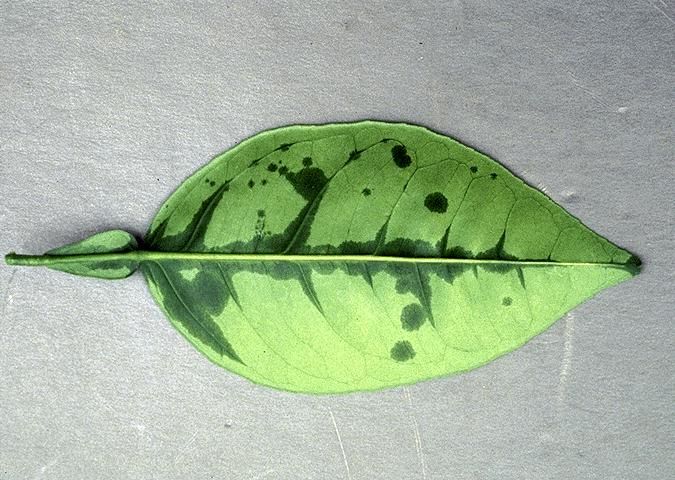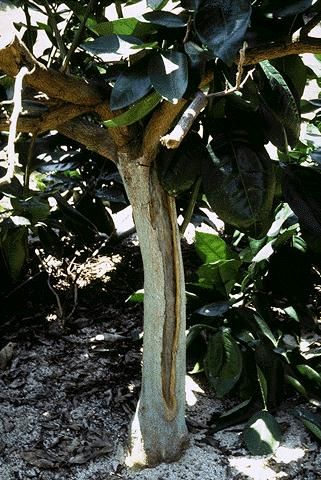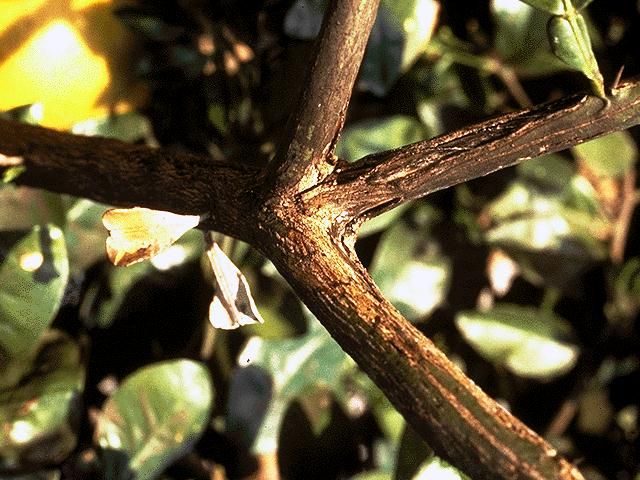Tree dormancy at the time of a freeze is probably the most important factor that influences the susceptibility of citrus to freezing temperatures. Citrus trees are evergreen, never becoming fully dormant and unable to withstand temperatures as low as those tolerated by deciduous trees. Cold weather preconditioning induces a degree of dormancy in citrus if it comes gradually. Trees in active growth are more severely injured by cold than those that are somewhat dormant. One of the best ways to lessen cold injury and to hasten recovery from cold damage is to maintain healthy trees. Follow cultural practices that tend to induce dormancy in the early winter and strive to maintain this dormancy until all cold weather has passed. Ability to recover from cold damage depends largely on tree vigor. Weak trees showing disease, insect damage, or nutrient deficiency symptoms are usually the ones most severely damaged and slowest to recover.
Symptoms of Cold Damage
Citrus leaves commonly assume a drooping or wilted appearance during periods of low temperatures, but remain firm and brittle if frozen. The leaves first become slightly flaccid as they thaw and, if injury is not too severe, they gradually regain normal turgidity and recover. Seriously frozen leaves, however, gradually collapse and dry out; this is accelerated by warm, sunny days immediately following a freeze. The youngest leaves are most easily injured, but all leaves may be killed in a severe freeze. If twigs are seriously frozen, the leaves dry out and remain attached for several weeks. However, the damaged leaves are shed rather promptly if the twigs and larger wood are not seriously injured. Cold damage on trunks and larger branches may appear as splitting or loosening of the bark. Certain areas, especially at or near crotches, are particularly sensitive. Localized damage to patches of bark on the trunk and larger limbs (cold cankers) are often mistaken for gummosis, since these may exude gum at a later date.



Care of Bearing Groves
Rules for the care of citrus trees that have been injured by cold must be flexible and varied. Time of year at which the cold occurs, condition of the trees at time of injury, and weather conditions immediately following injury will influence to a marked degree the type of treatment to use. The natural reaction after a freeze is to do something right away. Actually there is very little that can be done at that time, as it is impossible to determine the full extent of injury. Twigs and branches may continue to die for a period of several months to as long as two years following a severe freeze due to latent damage to the bark and wood that may not be apparent soon after a freeze. Citrus trees on which twigs and branches have been killed by cold should receive extra care during the following season. Thus, a "wait and see" attitude is best.
Fertilization
Fertilizer should be applied at the regular time, but the amount of fertilizer should be reduced in proportion to the amount of tree damage. A reduction in the pounds of nutrients per acre may be in order where twigs and limbs have been damaged, especially if it is obvious that there will be a light crop. For example, if 1/2 of the tree has been killed then 1/2 the regular fertilizer should be applied. However, it is best to treat these trees as young trees in that the total amount of fertilizer should be applied in 3 to 4 applications. Trees that experience a top-kill will also lose a portion of their root system. Therefore, there is no point in over-fertilizing. Another factor to consider is whether fruit will be produced in the year following a freeze. For example, trees suffering 10%-15% wood loss should receive a regular nutritional application as fruit will be produced that year. Trees suffering 50%-60% wood loss will not produce fruit that year and the nutritional program should be adjusted accordingly. Research has produced no definite guidelines in this area as yet, so the production manager still must make his decision based upon the local situation. Nutrient deficiency symptoms may be intensified in freeze-damaged trees due to the drain entailed by the large amount of growth necessary to replace lost foliage. Thus, a post-bloom nutritional spray of copper, zinc, and manganese usually will be beneficial to new growth and tree condition. After a freeze trees will continue to lose some initial flush as die-back continues. It is important not to apply nutritionals until a canopy has been established to catch them. Apply potash and nitrogen to increase leaf size because trees tend to produce small leaves for a few years after suffering total leaf loss.
Irrigation
Irrigation during warm periods in the winter following cold injury should be avoided because it may induce new growth that might be damaged by later freezes. If freeze-damage occurs early in the winter and soil moisture is adequate, it will be well to delay irrigation in hopes of delaying tree growth until the danger of additional freezes has passed. On the other hand, trees that put forth new growth should not be allowed to wilt for the lack of water. In this case, growth has commenced and withholding water will only retard subsequent growth.
Pruning
Cutting dead wood from bearing trees which have suffered heavy damage should not be done until late spring or early summer following the injury. This delay is desirable since it is difficult to determine the actual extent of injury until new growth commences. It is well to remember when pruning that all cuts should be made into living wood and, where possible, at crotches, leaving no stubs or uneven surfaces. It is advisable to remove heavy brush from the grove immediately following the pruning operation to aid subsequent production activities.
Weed Control
Weed control will be essential to rapid recovery from freeze-damage, as weeds will compete heavily with the trees for available moisture, nutrients, and, in some cases, light. Weed populations should be at low levels following a freeze, which will provide growers with a good opportunity to get many troublesome species under control.
Once the spring arrives, the weeds will begin to rapidly grow. Weed growth under the tree canopy will be greater following a freeze as more light will be reaching the soil surface, which promotes weed growth. Application of both pre and post emergent herbicides would be advisable prior to excessive weed growth.
Disease Control
Greasy Spot Control After a Freeze
With loss of foliage, growers cannot afford to lose any of the new flush. Because of the lost foliage, the year following a freeze will probably have three to four major flushes. Fungicide applications in July and September may be needed.
Melanose Control Following a Freeze
Melanose control after a freeze is still a difficult decision for the production manager to make. If fruit is expected that year a fungicide application may increase pack-out. Even on non-fruiting trees one or two fungicide applications should probably be made to help prevent infection of some new flush. However, the percentage of leaves with melanose will still be very high. Only weekly applications would provide complete control and this is not economically advisable. If you are applying a nutritional spray, you should certainly include copper.
Care of Young Trees
Slight Damage
If damage is slight and there are some leaves and green twigs above the bank or wrap, no special steps need to be taken. Trees in such instances have sufficient living wood to develop new tops. Even so, the banks or wraps should be removed from a few trees and the trunks inspected to see that the bark is firm. This process should be repeated at weekly intervals as damaged trees often "sweat" in the bank or wrap and may be attacked by a fungus that can quickly damage or kill a young tree.
Heavy Damage
If the tree has been killed to or into the bank or wrap, it may be a good practice to remove the entire bank or wrap, or at least a portion of it, to expose live tissue to sunlight and air. Otherwise, the bark beneath the bank or wrap may soften and slough off, resulting in complete loss of the tree. The extent of this operation will depend upon the acreage involved and the manpower available. When trees are unbanked or unwrapped, it will be necessary to rebank or rewrap them when freezing temperatures are forecast. Banks or wraps should be again removed as soon as the danger of cold has passed. This process may need to be repeated several times before the winter is over.
Trees That Were Not Banked
Trees that were not banked at the time the cold came should not be banked until the next forecast of freezing temperatures. It is useless and often detrimental to bank trees immediately following a freeze, as they are likely to "sweat" in the bank and be more severely damaged than if unbanked. Wait until the forecast of additional freezing temperatures to bank.
Cultural Practices
If tree damage is slight, exert every effort to keep the young tree as dormant as possible until the risk of freeze events have passed for the season. If heavy damage has occurred, in addition to removing the banks, it may be necessary (depending on conditions) to water the trees. Pruning, fertilization, and spraying should be delayed until the danger of subsequent freezes has passed.